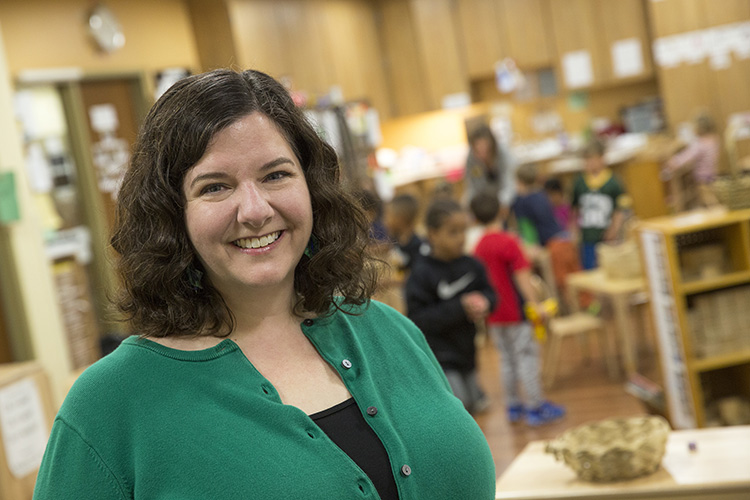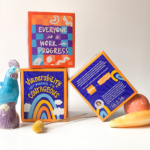Recent protests against police brutality and racial inequality may raise questions among children about racism in America. In this UWM Report story, originally posted on Feb. 9, 2018, associate professor Erin Winkler offers advice about how to talk to children about race, guidance that may be relevant in light of current events.
Racism remains a problem in America, despite hopes that the country was ready to leave that problem behind and become a “post-racial” society. But parents still are often using post-racial language in talking about race to young children.
That, says Erin Winkler, is a mistake.
“Adults often think they should avoid talking with young children about race or racism because doing so would cause them to notice race or make them racist. In fact, the opposite is true,” she recently wrote in a Buzzfeed post, “Here’s How to Raise Race-Conscious Children.”
Winkler, an associate professor of Africology and urban studies, has studied the way children absorb the lessons of race, and found that children form racial impressions from environmental cues around them. That makes frank, age-appropriate discussions of race an important part of their awareness of racial issues.
She is frequently invited to speak to parents and teachers about how to talk about race with children, and has served as a consultant to the National Museum of African American History and Culture.
“It’s hard to talk to little kids about race,” Winkler acknowledges. “People prefer to talk to older children, who can appreciate the abstractions we’re comfortable using to discuss this complex issue.
“On the other hand, parents want to answer their children’s questions.”
How children perceive the world
Young children are not blind to race, Winkler points out. They see who is more likely to hold higher-status jobs at their school or doctor’s office, or “who’s the Disney princess.”
“When I talk to adults, I encounter this general notion is that little kids are colorblind and don’t have biases,” she says. “Adults are frequently surprised that we see consistent biases in kids who are 3 to 5 years old. And they want to know why, because adults think you’re only biased if you are a bad person or are racist, and how can a young child be a racist or a bad person?”
Winkler says it’s not a question of good or bad, but rather the way young minds absorb cues from their environment. And this points to the need for adults to help them.
“Little kids are trying to solve puzzles, see patterns and understand rules,” Winkler said. “And we’re teaching them to categorize and match things like shapes and colors at this age.”
“If children don’t get answers about, for example, why they see disproportionally white people in this neighborhood and black people in this neighborhood, they might think, ‘There’s a rule no one’s talking about.’”
If children ask questions about this, adults may become uncomfortable, and may even give gruff responses that make kids think they are in trouble.
Systemic racism
Which brings us to the second issue Winkler addresses: There are systemic forms of racism that are difficult for children to comprehend, but can also be difficult for adults to recognize or admit – and discuss with kids.
“Parents of color have to be concerned about demoralizing their children with talk of systemic unfairness,” she says. “White parents need to consider how to give kids a sense of responsibility, as opposed to guilt and shame.”
She points out that, in order to speak effectively about race, adults need to first get comfortable talking about race with other adults. That means exposing ourselves to challenges to our preconceptions and attitudes.
“You have to get comfortable as an adult talking about this stuff to other adults,” she said. “If you can’t talk to a 40-year-old why this is happening, then you won’t be able to talk to a 4-year-old about why this is happening.”
Difficult discussions
Winkler recognizes that it’s not easy to talk about something as fraught as race.
“Get rid of the guilt,” she advises. “It’s not your fault that you weren’t taught in schools about how systemic structures of racism have created many inequalities.
“But it is your responsibility now to learn about it, to practice talking to adults about it, and to do something about it. Then you can learn to teach children about it in age-appropriate ways.”
In her talks to adults, Winkler offers practical suggestions about how to talk to kids about race.
Talk about fairness
She suggests using the concept of fairness, which is clear and powerful to young children, but also to empower children to respond to unfairness.
“You can empower a 4-year-old by pointing out people in the community who are addressing inequality,” Winkler says, “or have them participate with you in efforts to, for example, work with the school library to ensure adequate representation of characters of color in books.”
Since the history of racism in America is so complex, Winkler says, it’s useful to give young children concrete activities as analogies to abstract concepts. One such activity is the “spiderweb,” in which children roam a room unravelling balls of string. When asked to roll their string back up, they see that untangling the string – like untangling unfairness – is not so easy, though it can be done with time.
Winkler’s approach to talking to children is based on what one researcher called her “groundbreaking” framework of “comprehensive racial learning,” which Winkler first introduced in her 2012 book “Learning Race, Learning Place: Shaping Racial Identities and Ideas in African American Childhoods.”
“We’ve been looking at what adults tell kids, focusing on kids as empty vessels,” she said. “What we need to do is focus on the kids as active learners and agents, fielding and interpreting messages they are getting from all over – parents, teachers, media messages, and just what they see in the world.”







